
Parashurama, also referred to as Rama Jamadagnya, Rama Bhargava and Virarama, is the sixth avatar among the Dashavatara of the preserver god Vishnu in Hinduism. He is believed to be one of the Chiranjivis (Immortals), who will appear at the end of the Kali Yuga to be the guru of Vishnu's tenth and last incarnation, Kalki.
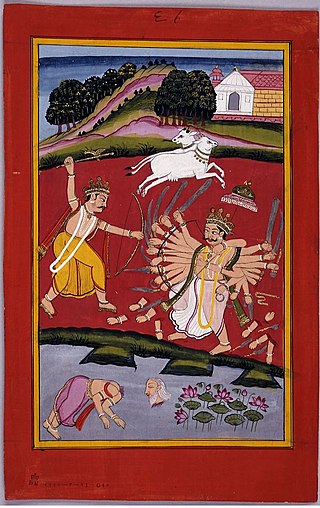
Jamadagni is a sage in Hindu literature. He is regarded in Hindu tradition to be one of the Saptarishi in the 7th, and the current age of Manvantara.

Lakshmana, also known as Laxmana, Saumitra and Ramanuja, is a Hindu god and the younger brother of Rama in the Hindu epic Ramayana. He is considered as an incarnation of Shesha, the lord of the serpents and is the husband of Urmila, an avatāra of Nagalakshmi. Lakshmana is known for his loyalty and dedication towards Rama.

Rishyasringa is a rishi mentioned in Hindu and Buddhist scriptures from the late first millennium BCE. According to the Hindu epics Ramayana and Mahabharata, he was a boy born with the horns of a deer who became a seer and was lured by royal courtesans, which led to the yajna of King Dasharatha. His story also occurs in the Buddhist Jatakas, where he is mentioned as the son of Bodhisatta and was tried to be seduced by royal courtesans.

Guruvayurappan also rendered as Guruvayoorappan, is a form of Vishnu worshipped mainly in Kerala, India. He is the presiding deity of the Guruvayur Temple, who is worshipped as Krishna in his child form, also known as Guruvayur Unnikkannan. The temple is located in the town of Guruvayur, Thrissur, Kerala, which is named after the deity.

The Vadakkumnathan Temple is an ancient Hindu temple dedicated to Shiva in Thrissur, in the Thrissur district of Kerala, India. The temple is a classical example of the architectural style of Kerala and has one monumental tower on each of the four sides in addition to a koothambalam. Mural paintings depicting various scenes from the Mahabharata can be seen inside the temple. The shrines and the Kuttambalam display vignettes carved in wood. The temple, along with the mural paintings, has been declared as a National Monument by India under the AMASR Act. According to popular local lore, this is the first temple built by Parashurama, the sixth avatar of Vishnu. Thekkinkadu Maidan, encircling the Vadakkumnathan Temple, is the main venue of the renowned Thrissur Pooram festival.
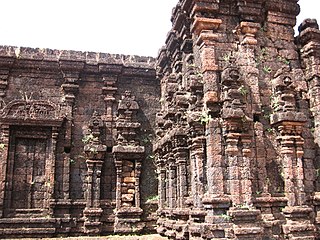
The Rajarajeshwara temple is a Shiva temple located in Taliparamba in Kannur district of Kerala State of India. The temple is regarded as one of the existing 108 ancient Shiva Temples of ancient Kerala. It also has a prominent place amongst the numerous Shiva temples in South India. It had the tallest shikhara amongst the temples of its time. The Rajarajeshwara temple has a top of about 90 tonnes. If any problem is encountered in the other temples of South India, devotees seek a solution in this temple through a prashnam, a traditional method of astrological decision-making. The prashnam is conducted on a peedha outside the temple.
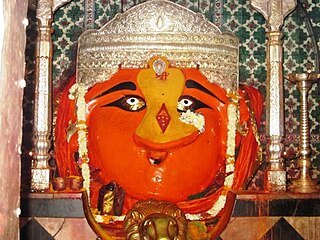
Renuka, also known as Yellamma, is a Hindu mother Goddess worshipped predominantly in the South Indian states of Karnataka, Tamil Nadu, Telangana, Kerala, Andhra Pradesh and the western state of Maharashtra. She is the mother of Parashurama, the sixth avatar of god Vishnu. She was given the name "Renuka" and acquired the status of a mother goddess before eventually being associated with the legend of Parashurama.
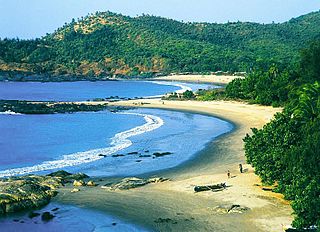
Gokarna is a small temple town located in the Uttara Kannada district of Karnataka state in southern India, It has a population of around 20,000. Shiva is the most worshipped deity in the town. Gokarna's main temple, Mahabaleshwara, is dedicated to Shiva. The temple houses what is believed by some to be the earliest Shiva lingam (Atmalinga).

Kadri Manjunatha Temple is a historic temple in Mangalore in the state of Karnataka, India. The incharge and priests in the temple are Shivalli Madhva Brahmins.
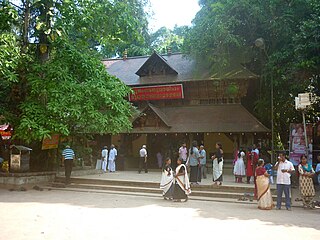
Mannarasala Sree Nagaraja Temple in Haripad is a very ancient and internationally known centre of pilgrimage for the devotees of serpent Gods (Nagaraja). The famous Nagaraja temple "Mannarasala" in Haripad is nestled in a forest glade, like most snake temples. The Mannarasala Temple has over 100,000 images of snakes along the paths and among the trees, and is the largest such temple in Kerala, India. Couples seeking fertility come to worship here, and upon the birth of their child come to hold thanksgiving ceremonies here, often bringing new snake images as offerings. A special turmeric paste which is available at the temple is credited with curative powers.

The Vilwadrinatha Temple is a Hindu temple in Thiruvilwamala, a town in the city of Thrissur, Kerala, India. The principal deities are Rama, the seventh incarnation of the god Vishnu, and his brother, Lakshmana. It figures among the Abhimana Kshetrams in Vaishnavite traditions. This is one of the four major Rama temples in Kerala — the other three are in Thriprayar, Kadavallur, and Thiruvangad. The temple houses an idol of Lakshmana, which is rare in India. Vilwadrinatha Temple is located in the centre of the community of Thiruvilwamala, atop a 100-foot-high hillock. Visible from the temple is Bharathappuzha, the second-largest river in Kerala, which flows past the temple's northern side from around 3 kilometres away.

The Dashavatara are the ten primary avatars of Vishnu, a principal Hindu god. Vishnu is said to descend in the form of an avatar to restore cosmic order. The word Dashavatara derives from daśa, meaning "ten", and avatāra, roughly equivalent to "incarnation".

The Sree Vaikom Mahadeva Temple is a temple dedicated to the Hindu god Shiva in Vaikom, Kerala, India.
Sahyādri-khaṇḍa is a Sanskrit-language text, notable for containing the founding myths of several Brahmin communities of south-western India. The text claims to be a part of the Skanda Purana. It is actually a collection of disparate texts that date from 5th to 13th centuries, and have been organized as part of a single text relatively recently.

Mahendragiri, is a mountain in Rayagada block of the district of Gajapati, Odisha, India. It is situated amongst the Eastern Ghats at an elevation of 1,501 metres (4,925 ft).
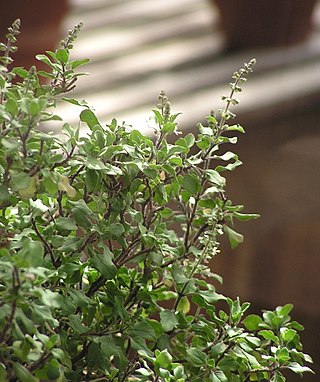
Tulasi, or Vrinda is a sacred plant in Hindu tradition. Hindus regard it as an earthly manifestation of the goddess Tulasi; she is regarded as the avatar of Lakshmi, and thus the consort of the god Vishnu. In another iteration, as Vrinda, she is married to Jalandhara. The offering of its leaves is recommended in ritualistic worship of Vishnu and his avatars, like Krishna and Vithoba.
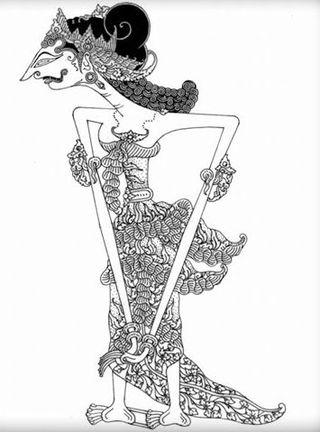
Amba is a character in the Hindu epic Mahabharata. She is the eldest and most beautiful daughter of Kashya, the King of Kashi, and the sister of Ambika and Ambalika.
Manipura, also known as Manalura, is a kingdom mentioned in the Hindu epic Mahabharata. According to the epic, it was located near a sea-shore, the Mahendra Mountains and the Kalinga Kingdom. Arjuna—one of the five Pandava brothers—visited Manipura and married Chitrangada, the princess of the kingdom. They had a son named Babruvahana who later ruled it.

Parashurama Jayanti is a Hindu festival observed to celebrate the birth of Parashurama, the sixth incarnation of Vishnu. It is celebrated every year on Akshaya Tritiya, falling on the tritiya tithi of the Shukla Paksha in the Hindu month of Vaisakha.
















